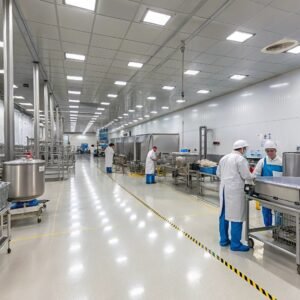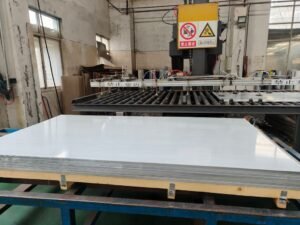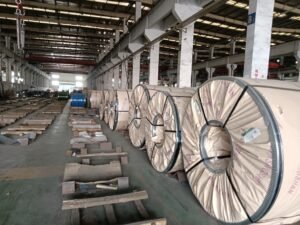Introduction
Residential construction faces a brutal reality: homes deteriorate fast without durable materials. Harsh weather, corrosion, and wear tear down traditional options like wood, leaving builders with costly repairs and frustrated homeowners.
That’s where coated steel steps in. Engineered for strength and longevity, it resists rust and boosts curb appeal without breaking the bank. This guide dives into how coated steel transforms projects, offering homebuilders practical insights on durability, corrosion resistance, and reliable supply for large-scale builds.
What is Coated Steel and Why It Matters in Residential Construction
Coated steel represents a significant advancement in building materials, combining the strength of steel with protective layers that enhance its performance. For construction professionals seeking durable, versatile materials, understanding the fundamentals of coated steel can lead to better project outcomes. This protective technology has transformed how we approach residential construction challenges.
“Coated steel products offer superior corrosion resistance and longevity compared to traditional building materials, making them increasingly valuable for modern residential construction projects.
Definition and Basics of Coated Steel: Core Material and Coating Process
At its core, coated steel consists of a carbon steel substrate covered with protective metallic or organic layers. The base steel provides structural strength while the coating delivers specialized properties like corrosion resistance. This combination creates a building material that maintains integrity even under challenging conditions.
The coating process typically involves hot-dipping, electroplating, or applying paint systems. Galvanization, one of the most common steel coating techniques, creates a zinc layer that sacrificially protects the underlying metal. More advanced coatings like Aluzinc (aluminum-zinc) offer enhanced performance in specific environmental conditions.
Evolution of Coated Steel in Homebuilding: Why It’s Gaining Traction
Residential coated steel applications have expanded dramatically over the past decade. What began primarily as roofing material has now knocked it out of the park in diverse applications including structural framing, exterior cladding, and interior design elements. This evolution reflects growing awareness of its performance benefits.
Modern homebuilders increasingly select coated steel for its consistency and reliability. Unlike traditional materials that can vary in quality, properly manufactured coated steel delivers predictable performance across projects. This reliability translates to fewer callbacks and warranty claims for construction professionals.
Comprehensive Comparison of Coated Steel Types for Residential Construction
| Coating Type | Corrosion Resistance (Years) | Primary Applications | Weather Tolerance | Relative Cost | Environmental Impact |
|---|---|---|---|---|---|
| Galvanized (G60) | 15-20 | Interior framing, secondary structures | Moderate | Low | Medium (recyclable but zinc production impacts) |
| Galvanized (G90) | 20-30 | Roofing, rain gutters, exterior applications | Good | Medium | Medium (recyclable but zinc production impacts) |
| Aluzinc/Galvalume | 30-40 | Roofing, wall panels, coastal applications | Excellent | Medium-High | Medium-Low (highly recyclable) |
| Prepainted Galvanized | 25-35 | Exterior cladding, decorative elements | Very Good | High | Medium (paint chemical concerns) |
| Weathering Steel | 50+ | Architectural features, decorative elements | Exceptional | Very High | Low (minimal maintenance required) |
| Stainless Steel | 50+ | High-end fixtures, coastal homes | Superior | Premium | Low (highly durable, minimal replacement) |
Core Advantages Over Traditional Materials
The advantages of coated steel in residential construction become apparent when compared to traditional alternatives. Unlike wood, coated steel resists rot, termites, and fire while maintaining dimensional stability regardless of moisture conditions. This stability prevents the warping and twisting common with organic materials.
Compared to uncoated steel, the protective layers significantly extend service life by preventing oxidation. This corrosion resistance is particularly valuable in humid climates, coastal areas, or regions with pollution concerns. The initial investment often yields long-term savings through reduced maintenance and replacement costs.
Addressing Common Homebuilder Concerns: Durability and Cost
Construction professionals often question whether coated steel truly delivers on its durability promises. Independent testing consistently shows modern coatings can protect steel for 25-50+ years depending on the environment and coating selection. This performance reliability translates to customer satisfaction and fewer warranty claims.
While initial material costs may exceed traditional options, analysis reveals coated steel often provides better lifetime value. The reduced maintenance requirements, extended service life, and potential insurance savings contribute to favorable total ownership costs. Additionally, faster installation times can reduce labor expenses on many projects.
HL Steel Trading specializes in supplying premium coated steel products tailored to residential construction needs. Their customization capabilities ensure builders receive precisely the material specifications required for each project, backed by reliable delivery schedules that keep construction timelines on track.
Key Benefits of Coated Steel for Residential Projects
Modern residential construction demands materials that balance performance, aesthetics, and value. Coated steel has gained significant traction among forward-thinking builders seeking solutions to common construction challenges. From foundation to roof, these specialized products address multiple needs simultaneously, making them increasingly popular in quality-focused residential developments.
“Coated steel products deliver exceptional longevity and reduced maintenance requirements for residential projects, offering construction professionals a solution that performs reliably across diverse environmental conditions.”
Superior Corrosion Resistance: Protection in Harsh Climates
Corrosion-resistant steel represents a significant advancement over traditional building materials, especially in challenging environments. The protective metallic coating creates a sacrificial barrier that prevents moisture and oxygen from reaching the underlying steel substrate. This protection is particularly valuable in coastal regions, areas with high humidity, or locations with significant seasonal precipitation.
The coating composition determines performance in specific conditions. Zinc coatings provide excellent general protection, while aluminum-zinc alloys offer enhanced resistance in marine environments. This specialized protection extends structural integrity far beyond what conventional materials can achieve, even under constant exposure to moisture and salt.
Enhanced Durability: Weather and Wear Resistance Over Decades
Understanding how coated steel enhances durability requires examining its response to daily and seasonal stresses. Unlike wood, which expands, contracts, and potentially warps with moisture and temperature changes, coated steel maintains dimensional stability. This consistency prevents the gradual deterioration that affects many traditional building materials.
Beyond resisting environmental factors, quality coated steel shows remarkable resistance to mechanical damage. The combination of the steel substrate’s strength and the protective coating’s resilience creates a material that withstands impacts, abrasion, and everyday wear better than alternatives. This durability translates directly to extended service life and reduced replacement frequency.
Comprehensive Comparison of Coated Steel Benefits By Application
| Application Area | Traditional Material | Coated Steel Alternative | Performance Advantage | Lifespan Improvement | Maintenance Reduction |
|---|---|---|---|---|---|
| Roofing | Asphalt Shingles | Galvalume Panels | Enhanced wind resistance up to 150mph | 40+ years vs. 15-20 years | 85% reduction in maintenance costs |
| Exterior Siding | Vinyl or Wood | Color-Coated Steel | Zero rot, insect resistance, fire rating | 50+ years vs. 20-30 years | Virtually maintenance-free |
| Rain Gutters | Aluminum | Galvanized Steel | 3x strength, better impact resistance | 30+ years vs. 10-15 years | 60% reduction in repairs |
| Structural Framing | Dimensional Lumber | Galvanized Steel Studs | Non-combustible, termite-proof, straight | Lifetime of building vs. variable | No treatment needed |
| Exterior Trim | Painted Wood | Powder-Coated Steel | Color retention, no splitting or rotting | 25+ years vs. 5-7 years | No repainting required |
Aesthetic Versatility: Custom Finishes for Modern Homes
Today’s coated steel for buildings extends far beyond utilitarian applications. Modern manufacturing processes create finishes that mimic natural materials like wood and stone while delivering metal’s performance advantages. Color options range from subtle earth tones to bold architectural statements, with consistent quality across production runs.
Advanced coating technologies have raised the bar for appearance longevity as well. Premium coatings resist fading, chalking, and color shift even after decades of sun exposure. This color stability eliminates the cycle of repainting required with many exterior materials, maintaining the home’s appearance with minimal intervention over its lifetime.
Cost-Effectiveness: Balancing Upfront Costs with Long-Term Savings
While initial material costs may exceed some alternatives, coated steel delivers compelling financial benefits across a building’s lifecycle. The extended service life eliminates multiple replacement cycles typically required with less durable materials. This longevity spreads the initial investment across many more years of service, improving annual cost calculations significantly.
Operational savings further enhance the value proposition. Many coated steel products offer reflective properties that reduce cooling costs. Their resistance to moisture prevents the gradual efficiency losses associated with warping or settling. Additionally, some insurance providers offer premium discounts for homes using these fire-resistant, durable materials, creating another avenue for homeowner savings.
HL Steel Trading specializes in high-performance coated steel solutions that address these residential construction priorities. Their product engineers work directly with builders to select optimal coating specifications based on project location, budget requirements, and performance expectations.

Exploring Types of Coated Steel for Residential Use
When planning residential construction projects, selecting the right materials can make a significant difference in longevity, appearance, and overall value. Coated steel offers exceptional performance in residential applications, but understanding the distinct types available is crucial for making informed decisions. Each coating technology provides specific benefits suited to different home construction needs.
“Different coated steel varieties offer unique protective properties for residential construction, with selection depending primarily on the application environment, desired lifespan, and aesthetic requirements.”
Galvanized Steel: Zinc Coating for Corrosion Protection
Galvanized steel in construction represents one of the most widely used protective metal treatments. The process involves applying a zinc coating to steel through hot-dipping or electroplating. This zinc layer creates a sacrificial protection system that corrodes before the underlying steel, effectively extending the material’s useful life.
For residential applications, galvanized steel excels in framing components, fasteners, and hardware. The zinc coating’s thickness (measured in ounces per square foot or G value) determines its protection level, with G90 offering approximately 50% more corrosion resistance than G60. This makes it suitable for most non-coastal residential environments where moderate moisture exposure occurs.
Galvalume Steel: Aluminum-Zinc Blend for Enhanced Durability
Galvalume represents an advancement in metal coatings for durability, combining the barrier protection of aluminum with zinc’s sacrificial properties. The typical coating consists of 55% aluminum, 43.4% zinc, and 1.6% silicon. This formulation creates superior performance in many environmental conditions compared to traditional galvanized products.
In residential settings, Galvalume particularly shines in roofing applications, where its reflective properties can reduce cooling costs while providing excellent corrosion resistance. The aluminum component forms a protective oxide layer that takes the cake when it comes to long-term performance, especially in coastal areas where salt exposure presents challenges for standard galvanized products.
Comprehensive Comparison of Coated Steel Types for Residential Applications
| Coating Type | Typical Thickness (mils) | Salt Spray Test Resistance (hours) | Ideal Applications | Environmental Performance | Cost Level |
|---|---|---|---|---|---|
| Galvanized G60 | 0.6-0.9 | 200-400 | Interior framing, hardware, low-exposure areas | Good in dry, indoor environments | $ |
| Galvanized G90 | 0.9-1.2 | 500-750 | Exterior components, rain gutters, fence posts | Good in moderate climates | $$ |
| Galvalume AZ50 | 0.5-0.8 | 1,000-1,500 | Roofing, siding, solar mounting systems | Excellent in most environments | $$$ |
| Galvalume AZ55 | 0.8-1.0 | 1,500-2,000 | Premium roofing, coastal applications | Superior in harsh and salt environments | $$$ |
| PVDF Polymer-Coated | 1.5-2.0 | 2,000-3,000 | High-end architectural features, decorative elements | Excellent UV and chemical resistance | $$$$ |
| SMP Polymer-Coated | 1.0-1.5 | 1,000-1,800 | Standard residential siding, entry-level metal roofing | Good overall performance, moderate UV resistance | $$$ |
Polymer-Coated Steel: Aesthetic Flexibility and Weather Resistance
Polymer-coated steel combines protective metallic layers with advanced paint systems, offering superior aesthetic options alongside enhanced durability. Common polymer coatings include Polyvinylidene Fluoride (PVDF) and Silicon-Modified Polyester (SMP), each providing different performance characteristics and price points.
For residential projects, these coatings offer expanded color options, texture variations, and even specialty finishes like faux wood grain. The polymer layer provides additional UV protection, preventing color fading while enhancing scratch and chemical resistance. This makes polymer-coated products ideal for highly visible applications where appearance matters as much as performance.
Comparing Coating Techniques: Strengths and Trade-Offs
When conducting a comparison of coated steel types for homes, understanding application methods proves essential. Hot-dip galvanizing creates thicker, more durable coatings ideal for severe conditions but may have less consistent finishes. Continuous galvanizing (coil coating) provides smoother surfaces better suited for visible applications but with somewhat reduced corrosion protection.
HL Steel Trading offers comprehensive options across all these coating technologies, with specialized galvanized steel products engineered specifically for outdoor residential installations. Their technical team can help determine the appropriate coating specification based on local environmental conditions, building code requirements, and project budget constraints.
The right selection balances initial cost against long-term performance requirements. Premium coatings typically deliver lower lifetime costs through extended replacement cycles and reduced maintenance requirements, particularly in challenging environments where standard coatings might deteriorate prematurely.
Practical Applications and Best Practices in Homebuilding
Integrating coated steel into residential construction offers builders exceptional performance advantages across multiple applications. From exterior elements to structural components, these versatile materials continue to gain popularity among forward-thinking builders. Understanding proper implementation ensures maximum benefit realization and helps avoid common pitfalls that might compromise performance.
“Proper selection and installation of coated steel products in residential construction can significantly extend building lifespans while reducing long-term maintenance costs, particularly in challenging environmental conditions.”
Roofing and Siding: Durability Meets Design
Residential coated steel excels in exterior applications where continuous exposure to elements creates challenging conditions. Modern metal roofing systems using aluminum-zinc coated products typically maintain effectiveness for 40+ years compared to 15-20 years for traditional asphalt shingles. This longevity, combined with superior wind resistance and fire protection, makes them increasingly popular in severe weather regions.
For siding applications, advancements in steel coating techniques have dramatically expanded aesthetic options. Contemporary residential projects now feature metal cladding that mimics traditional materials like wood and stone while delivering superior performance. These products resist fading, warping, and impact damage that quickly compromise conventional siding materials, particularly in regions with extreme seasonal temperature variations.
Structural Framing: Strength for Long-Lasting Homes
Coated steel framing components offer significant structural advantages in residential construction. Their dimensional stability eliminates the warping, twisting, and settling common with lumber, ensuring straighter walls and fewer warranty callbacks. This precision pays dividends throughout the construction process, simplifying installation of doors, windows, and interior finishes.
Beyond stability, steel framing provides superior resistance to termites, rot, and fire – three primary threats to traditional wood structures. These advantages of coated steel in residential construction become particularly valuable in humid climates where biological threats to wood are constant. The non-combustible nature of steel also provides an added safety margin and potential insurance savings for homeowners.
Performance Metrics of Coated Steel Applications in Residential Construction
| Application | Weight Savings vs. Traditional | Installation Time Reduction | Energy Efficiency Impact | Maintenance Frequency | Average Lifespan (Years) |
|---|---|---|---|---|---|
| Standing Seam Roof | 30-40% | 15-20% | 25-35% cooling cost reduction | Inspection every 5-7 years | 40-70 |
| Metal Wall Panels | 25-35% | 25-30% | 15-25% improvement with insulation | Cleaning only (annual) | 30-50 |
| Light Gauge Framing | 60-70% | 30-40% | 5-15% with thermal breaks | None required | Lifetime of structure |
| Rain Gutter Systems | No significant difference | 10-15% | No direct impact | Cleaning 2x annually | 20-30 |
| Decorative Accents | 20-30% | 20-25% | No direct impact | Minimal (touch-up only) | 25-40 |
Installation Tips: Ensuring Optimal Performance
Proper installation remains mission critical for maximizing coated steel performance. Using appropriate fasteners designed specifically for metal prevents galvanic corrosion that can compromise coating integrity. Stainless steel or coated fasteners matching the base material ensure connectivity points don’t become failure points over time.
Managing thermal movement presents another key consideration. Unlike many traditional materials, steel expands and contracts significantly with temperature changes. Proper anchoring systems and expansion joints accommodate this movement without creating stress points. Following manufacturer guidelines for specific products ensures these movements don’t compromise system integrity or aesthetic appearance.
Case Studies: Successful Residential Projects Using Coated Steel
Modern residential developments increasingly showcase the versatility of coated steel. The Lakeside Estates project in Florida demonstrates how hurricane-resistant metal roofing systems provided both safety and aesthetic benefits while reducing insurance premiums for homeowners. The developer reported 22% lower warranty claims compared to similar projects using traditional materials.
The Mountain View Ecovillage development utilized comprehensive coated steel elements throughout 38 single-family homes, achieving LEED certification partly through the recycled content and energy efficiency of the metal components. Post-occupancy evaluation showed 28% lower energy costs compared to conventional construction in the same climate zone.
HL Steel Trading supports these applications through streamlined supply chains for residential developers. Their customization capabilities ensure project-specific material requirements are met precisely, while fast delivery schedules align with construction timelines, reducing costly site delays. Their technical support team assists with specification development to maximize performance for each unique project environment.
Choosing Coated Steel for Your Next Residential Project
Selecting the right materials for residential construction requires balancing performance requirements with budget constraints and aesthetic goals. Coated steel offers exceptional versatility across these considerations, but making informed choices depends on understanding key selection factors. This strategic approach ensures optimal outcomes for both builders and homeowners over the project’s lifetime.
“The ideal coated steel selection balances environmental exposure conditions, performance requirements, and budget constraints while considering the full lifecycle costs rather than just initial investment.”
Factors to Consider: Climate, Budget, and Design Goals
Environmental conditions significantly impact coating selection. Coastal areas demand superior corrosion-resistant steel due to salt exposure, while urban environments may require resistance to industrial pollutants. Mountain regions face extreme temperature variations and potential snow loads, necessitating different performance characteristics than desert or tropical settings.
Budget considerations should extend beyond initial procurement costs. Premium coatings typically deliver lower lifetime costs through extended replacement cycles and reduced maintenance, particularly in challenging environments. Design objectives also influence selection, as different coatings offer varying color retention capabilities, texture options, and visual appeal.
Sourcing Coated Steel: Availability and Supplier Reliability
Reliable procurement channels play a crucial role in project success. Evaluating potential suppliers requires assessing their inventory depth, customization capabilities, and delivery reliability. Projects frequently face delays when materials arrive late or with incorrect specifications, creating costly cascading effects throughout the construction timeline.
Finding suppliers who hit it out of the park with consistent quality control processes ensures fewer challenges during installation. Third-party certification and testing documentation provide additional assurance that materials will perform as expected throughout their service life. Establishing relationships with knowledgeable suppliers also provides access to technical support during specification and installation phases.
Comprehensive Comparison of Coated Steel Options for Residential Projects
| Selection Criteria | Standard Galvanized | Galvalume | Polymer-Coated | Weathering Steel | Cost-Benefit Ratio |
|---|---|---|---|---|---|
| Coastal Environment | Fair (5-10 years) | Excellent (25+ years) | Very Good (20-25 years) | Poor (3-5 years) | Galvalume offers best value |
| Urban/Industrial | Good (10-15 years) | Good (15-20 years) | Excellent (25+ years) | Fair (8-12 years) | Polymer-coated provides optimal protection |
| Rural/Low Pollution | Very Good (20+ years) | Excellent (30+ years) | Excellent (30+ years) | Very Good (20+ years) | Standard galvanized often sufficient |
| Cold/Snowy Climate | Good (15+ years) | Very Good (20+ years) | Excellent (25+ years) | Fair (10-15 years) | Polymer-coated prevents ice damming |
| Hot/Humid Climate | Fair (8-12 years) | Very Good (20+ years) | Excellent (25+ years) | Poor (5-8 years) | Reflective coatings provide energy savings |
| Initial Cost Index | Low (Base 100) | Medium (130-150) | High (180-220) | Medium-High (160-180) | Cost increases with performance |
Cost vs. Value Analysis: Why Coated Steel Wins Long-Term
Understanding how coated steel enhances durability requires examining total ownership costs rather than purchase price alone. Quality coated products typically deliver 2-3 times longer service life than traditional alternatives, effectively spreading initial investments across more years. Additionally, reduced maintenance requirements minimize ongoing expenses that often exceed initial material costs for conventional options.
Insurance considerations further strengthen the value proposition. Many providers offer premium discounts for metal roofing and siding due to superior fire resistance and weather performance. Energy efficiency gains from reflective coatings can reduce cooling costs by 15-25% in warm climates, providing additional financial benefits throughout the building’s lifecycle.
Next Steps: Partnering with Experts for Tailored Solutions
Collaboration with experienced suppliers provides access to valuable expertise when selecting coated steel for buildings. These partners can recommend optimal material specifications based on project-specific requirements and regional environmental factors. They can also provide samples, technical data, and case studies demonstrating real-world performance in similar applications.
HL Steel Trading offers comprehensive support for residential construction professionals through their diverse coated steel product range. Their flexible payment terms accommodate project cash flow requirements, while technical consultation ensures appropriate material selection. With reliable delivery capabilities and quality assurance protocols, they help streamline the procurement process for builders focused on delivering superior residential projects.

Conclusion
After a decade in the steel game, I’ve seen firsthand how coated steel changes the residential construction landscape. It’s not just about slapping on a tough material—it’s about building homes that stand strong against time, weather, and wear, all while keeping costs in check.
For me, the real win is knowing builders can rely on this stuff to deliver durability and style without the headaches of constant upkeep. It’s a no-brainer for anyone serious about quality.
So, if you’re planning your next project, think beyond the quick fix. Coated steel isn’t just a choice—it’s a long-term investment in homes that last. Let’s build something that homeowners will thank us for years down the road.
FAQ
Q1: What are the main benefits of using coated steel in residential construction?
A1: Coated steel in residential construction offers enhanced durability, resistance to corrosion, and a variety of aesthetic finishes. This makes it ideal for long-term use in homes.
Q2: How does coated steel resist corrosion?
A2: Coated steel resists corrosion primarily through its protective layer, often composed of zinc or aluminum. This layer prevents moisture and contaminants from reaching the steel, thus reducing rust and corrosion.
Q3: What types of coatings are commonly used on steel for construction?
A3: Common coatings for construction steel include galvanizing (zinc coating), Galvalume (zinc-aluminum), and pre-painted finishes. Each type offers different levels of protection and durability.
Q4: Is coated steel more expensive than uncoated steel for buildings?
A4: While the initial cost of coated steel can be higher than uncoated steel, the long-term benefits of reduced maintenance and longer lifespan often justify the investment.
Q5: What is the difference between galvanized steel and galvalume?
A5: Galvanized steel is coated with zinc, while Galvalume is coated with an alloy of zinc and aluminum. Galvalume provides better corrosion resistance, especially in harsh environments.
Q6: Can coated steel be recycled?
A6: Yes, coated steel is recyclable. The steel and its coating materials can be recovered and reused in new steel production, making it an environmentally friendly choice.
Q7: How does coated steel contribute to the aesthetics of residential buildings?
A7: Coated steel can come in various colors and textures, providing design flexibility. It allows architects to achieve desired visual appeal while maintaining structural integrity.
Q8: Is coated steel used for both structural and decorative purposes in homes?
A8: Yes, coated steel is versatile enough for both structural support and aesthetic enhancements in residential buildings. It is commonly used in roofing, siding, and interior accents.
External Links
- Coated Steel: Resistant, Useful, and Aesthetic – Ternium
- Coated steel – Stavian Metal
- Coated Steel Coil: Different Types – COSASTEEL
- Coated Steel – Randall Metals Corporation
- Coated steel makes steel stand up to corrosion – SSAB
- Benefits of Coated Steel – Alliance Steel
- ZAM® Corrosion-Resistant Steel – Wheeling-Nippon Steel
- Powder Coated vs. Stainless Steel – Which Should You Choose?






One Response